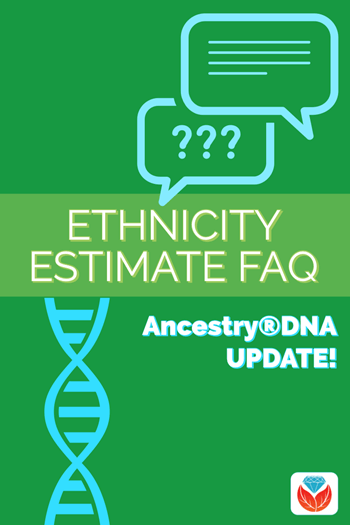by Lisa Cooke | Nov 3, 2019 | 01 What's New, Records & databases
The newest genealogy records to hit the Internet are exciting because of the wide range subjects they cover. Peruse these carefully because there just may be a genealogy gem waiting just for you!
New and Updated Free Records from FamilySearch
The newest additions to the FamilySearch collections are global in their reach, and best of all they are free. Here’s the latest:
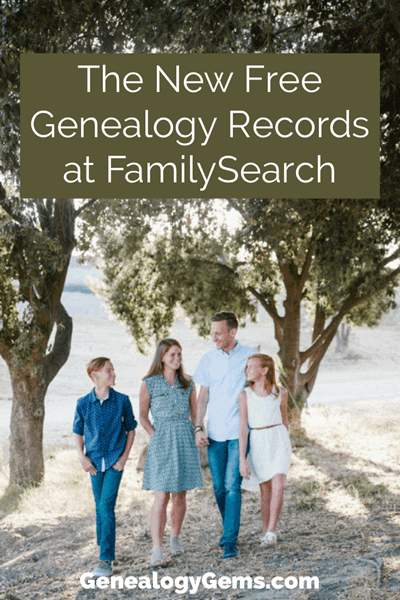
American Samoa
American Samoa, Vital Records, 1850-1972
2,874 Added indexed records to an existing collection
Argentina
Argentina, Salta, Catholic Church Records, 1634-1972
98,907 Added indexed records to an existing collection
Brazil
Brazil, Santa Catarina, Civil Registration, 1850-1999
4,072 Added indexed records to an existing collection
Canada
Manitoba Church Records, 1800-1959
58 Added indexed records to an existing collection
Chile
Chile, Catholic Church Records, 1710-1928
2,670 Added indexed records to an existing collection
Colombia
Colombia, Bogotá, Burial Permits, 1960-1991
18,221 Added indexed records to an existing collection
England
England, Oxfordshire Parish Registers 1538-1904
826 New indexed records collection
England, Yorkshire Marriage Bonds and Allegations, 1613-1887
960 New indexed records collection
England, Bedfordshire Parish Registers, 1538-1983
376,993 New indexed records collection
England, Devon Bishop’s Transcripts, 1558-1887
33,158 Added indexed records to an existing collection
England, Warwickshire, Parish Registers, 1535-1963
20,994 Added images to an existing collection
Finland
Finland, Tax Lists, 1809-1915
73,007 Added indexed records to an existing collection
France
France, Vienne, Census, 1876
20,638 Added indexed records to an existing collection
Peru
Peru, Cemetery Records, 1912-2013
565 Added indexed records to an existing collection
Peru, Huánuco, Civil Registration, 1889-1997
6,480 Added indexed records to an existing collection
Peru, Junín, Civil Registration, 1881-2005
365 Added indexed records to an existing collection
Peru, Prelature of Yauyos-Cañete-Huarochirí, Catholic Church Records, 1665-2018
680 New indexed records collection
United States
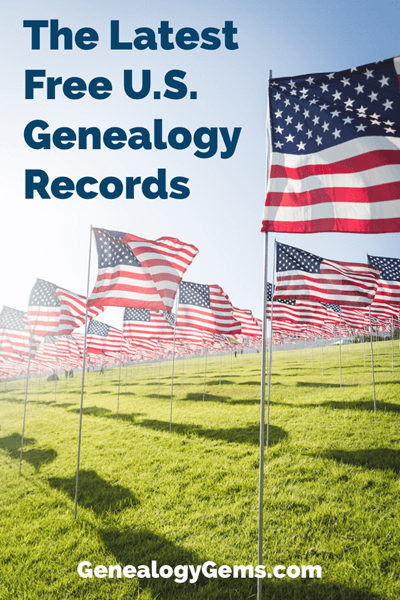 Alabama Deaths, 1908-1974
Alabama Deaths, 1908-1974
697 Added indexed records to an existing collection
Alabama, County Birth Registers, 1881-1930
6,638 Added indexed records to an existing collection
Alabama, Friends of Magnolia Cemetery, Funeral Books, 1911-1965
6,606 Added indexed records to an existing collection
California, Lassen County, State Board of Health, Burial Permits, 1931-1988
800 Added indexed records to an existing collection
Georgia, County Delayed Birth and Death Records, 1870-1960
7687 Added indexed records to an existing collection
Hawaii, Board of Health, Marriage Record Indexes, 1909-1989
10,729 Added indexed records to an existing collection
Illinois, Stark County Circuit Court, Stark County Naturalization Records
560 New indexed records collection
Louisiana, New Orleans, Interment Registers, 1836-1972
12,755 Added indexed records to an existing collection
Louisiana, Orleans Parish, Birth Records, 1819-1906
30,826 Added indexed records to an existing collection
Mississippi, Adams County, Natchez Death Index, 1835-1905
168 Added indexed records to an existing collection
Missouri, County Marriage, Naturalization, and Court Records, 1800-1991
5,678 Added indexed records to an existing collection
Nebraska, Grand Army of the Republic, Burial Records, 1861-1948
364 Added indexed records to an existing collection
North Carolina, Wake County, Death Records, 1900-1909
2,537 Added indexed records to an existing collection
South Carolina, Charleston County, Charleston, Birth Registers, 1901-1926
601 Added indexed records to an existing collection
Tennessee, Board of Health, Shelby County, Memphis Death Records, 1848-1913
1,061 New indexed records collection
Texas, Harrison County Delayed Birth Records, 1860-1933
196 Added indexed records to an existing collection
United States, GenealogyBank Historical Newspaper Obituaries, 1815-2011
98,269 Added indexed records to an existing collection
United States, Iowa Naturalization Records, 1859-1990
55,114 New indexed records collection
United States, Louisiana, Passenger Departures from New Orleans, 1867-1871
5,123 New indexed records collection
United States Census (Slave Schedule), 1860
4,429,408 Added indexed records to an existing collection
Virginia, Slave Birth Index, 1853-1866
13,135 Added indexed records to an existing collection
Wisconsin, Milwaukee, Pilgrim’s Rest Cemetery, Interment Records, 1880-1979
300 Added indexed records to an existing collection
Wales, Anglesey, Parish Registers, 1538-1912
281,418 Added indexed records and images to an existing collection
The Latest from Ancestry.com
Obituaries are a staple of genealogical research. Here’s the latest from the folks at Ancestry:
“Ancestry® updated its collection of US obituaries by combing through millions of digital obituaries to key names, relationships and other facts so members can now easily search these records with just one click.
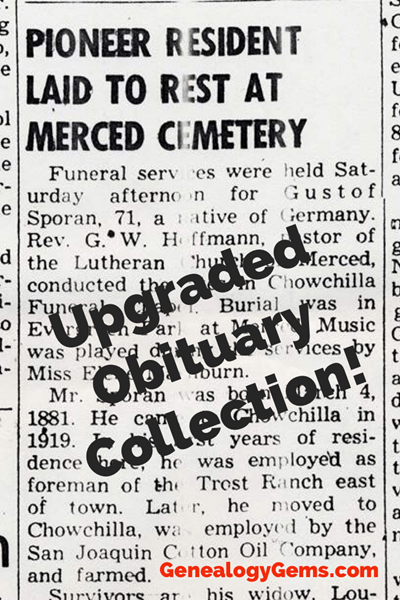
This initiative first announced at RootsTech uses new sophisticated artificial intelligence technology.
The new Newspapers.com Obituary Collection and the upgraded Ancestry U.S. Obituary Collection will expand Ancestry’s unparalleled historical record collections that enable people around the world to uncover their family history, spark their own journey of discovery and inspire meaningful conversations.
- Obituary collections include over 262 million worldwide obituaries and death announcements with almost 1 billionsearchable family members
- US Obituary Collection, 1930-Current search is the world’s largest, searchable digital archive, now includes 4x more searchable family members
- Newspapers.com Obituary Index includes facts from nearly 200 millionNewspapers.com obituaries
- Newspapers.com is the largest online newspaper archive, with over 525+ million pages of historical newspapers, including obituaries, from thousands of printed newspapers across the United States and beyond.
Members with an Ancestry All Access or Newspapers.com Basic subscription have a 1-click option to view the full obituary on Newspapers.com. Some images may require a Publisher Extra subscription as certain newspapers require additional licenses to view their content.”
Visit Ancestry here.
Visit Newspaper.com here.
Other Unique Collections Updated
From the State Archives of North Carolina blog comes a very interesting addition ton an existing Civil War digital collection:
A selection of 12 volumes from the Soldiers’ Home Association have been added to the Civil War digital collection. These volumes document the history of medical care for veterans and the elderly around the turn of the 19th century.”
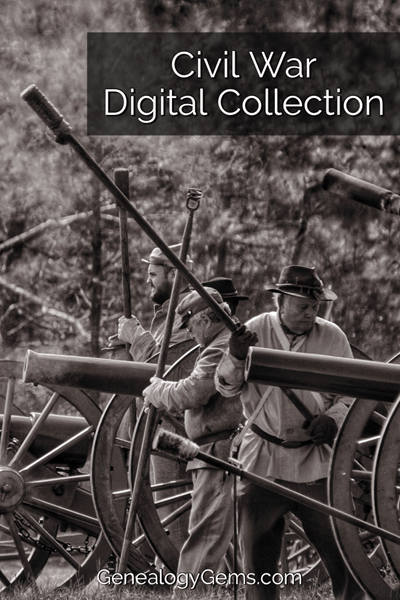
“These volumes provide recorded information on veterans’ military service, illnesses or injuries that might not have been recorded elsewhere. Some volumes include patients’ requests for their burial and funeral wishes. The volumes included are listed below:
Roll Book, 1890-1911
Register, 1890-1917
Record of Inmates, 1896-1924
Record of Inmates, 1925-1936
Record of Clothing Issued, 1926-1934
Hospital Patients, 1908-1916
Hospital Register, 1911-1919
Hospital Register, 1925-1930
Hospital Night Orders, 1918-1919
Hospital Night Orders, 1919
Hospital Night Orders, 1924
Hospital Night Orders, 1928-1929″
New British Genealogy Records

1801 Census
Discover your Scouse ancestor’s address, occupation and who they were living with in 1801. Findmypast now offers over 13,000 new and exclusive early census records. Don’t miss the images because they provide additional information about your ancestor’s abode.
The 1801 census was the first official census to be carried out in Britain. It estimated the population of England and Wales to be 8.9 million, and that of Scotland to be 1.6 million.
The 1801 census comprised two parts:
- the first was related to the number of people, their occupations, and numbers of families and houses.
- The second was a collection of the numbers of baptisms, marriages and burials, thus providing an indication of the rate at which the population was increasing or decreasing.
Click the following link to search the collection: 1801 Lancashire, Liverpool Census
Cornwall Burials
Over 75,000 new records covering 52 parishes across the Cornish peninsula are now available to search at Findmypast.
These transcripts reveal 5 key pieces of information:
- when your ancestor was buried
- where your ancestor was buried
- their age at death,
- residence
- and relatives’ names.
Click here to search the Cornwall Burials collection.
Kent Burials
And finally, Findmypast has added 12,000 new records to their collection last week. The majority of these new additions cover Swanscombe municipal cemetery and will reveal where and when your ancestor was buried as well as the names of their spouse and father. Click here to search the Kent Burial records.
New Records Coming Soon
Recently announced on the University of Georgia website:
“Through a new partnership with Google, about 120,000 of the Libraries’ 4.5 million volumes will be digitized, allowing further access to literary, historic, scientific and reference books and journals through UGA’s library catalog as well as one of the largest digital book collections in the world.”
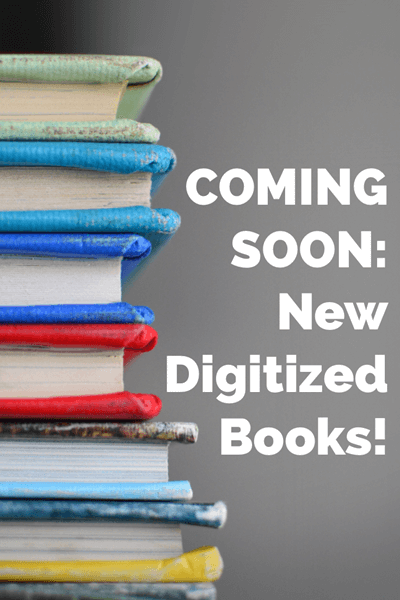
“In addition to more modern materials that will be available for preview online, other examples of volumes available in full text include shipping registers from as far back as 1764 and Atlanta city directories dating back to 1870.
The project also advances a longstanding effort to provide digital access to state and federal government publications, and free digital access will be available to works by Balzac, Sir Francis Bacon, Robert Louis Stevenson, Thomas Hardy and other historically significant authors, thanks to UGA Libraries.”
Read the full post here.
What Did You Discover this Week?
Did one of these new and updated digital genealogy collections deliver what you’ve been waiting for? Please share your discovering in the Comments below. And click here to subscribe to the free Genealogy Gems newsletter to receive all the latest in new and updated genealogy records for your family history.
by Lisa Cooke | Oct 29, 2019 | 01 What's New, School Records |
Have you found all the school records there are to be had for your ancestors? Most of us haven’t, and the chances are very good that there are still some gems out there waiting to be found. Here are ten solid strategies that will help you track them down for your genealogy research.
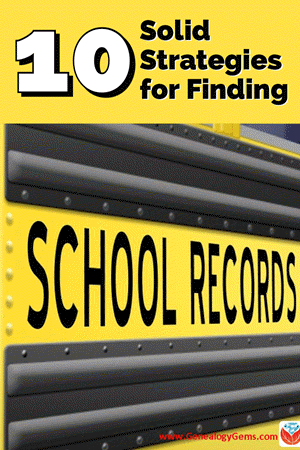
Because the movement for compulsory public education didn’t begin until the 1920s, many people assume that there few records to be had for genealogical purposes prior to that time. The reality couldn’t be further from the truth. Many children attended school much earlier.
In fact, it may be surprising to learn that the first public school in what is now the United States opened in the 17th century. On April 23, 1635, the first public school was established in Boston, Massachusetts.
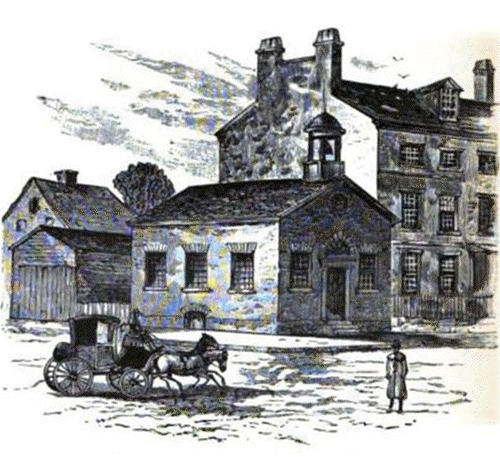
Illustration of the Boston Latin School by Ebenezer Thayer, courtesy of Wikimedia
It was a boys-only public secondary school called the Boston Latin School, and it was led by schoolmaster Philemon Pormont, a Puritan settler. The school was strictly for college preparation, and produced well-known graduates including John Hancock and Samuel Adams. It’s most famous dropout? Benjamin Franklin! The school is still in operation today, though in a different location.
Thousands of schools serving millions of students have been established in the U.S. since the inception of the Boston Latin School. (According to 2015-16 data from the National Center for Education Statistics (NCES) there are 132,853 K-12 schools in the U.S.) This means that the chances of there being school records for your ancestors is great indeed!
10 Solid Strategies for Finding School Records for Genealogy
Here are 10 proven ways to find your ancestors’ awkward yearbook photos, sports triumphs, and much, much more.
1. Establish a Timeline of your Ancestor’s Education
Check your genealogy software database to figure out when your ancestor would have attended high school or college. Keep in mind, as recently as the 1960s, children did not go to Kindergarten but may have started school at about 6 years old and beginning in First Grade.
To keep my search organized, I decided to create a simple worksheet form in a Word document. This allows me to identify the right time frames, locations, and other pertinent information for my search, and record my progress along the way.
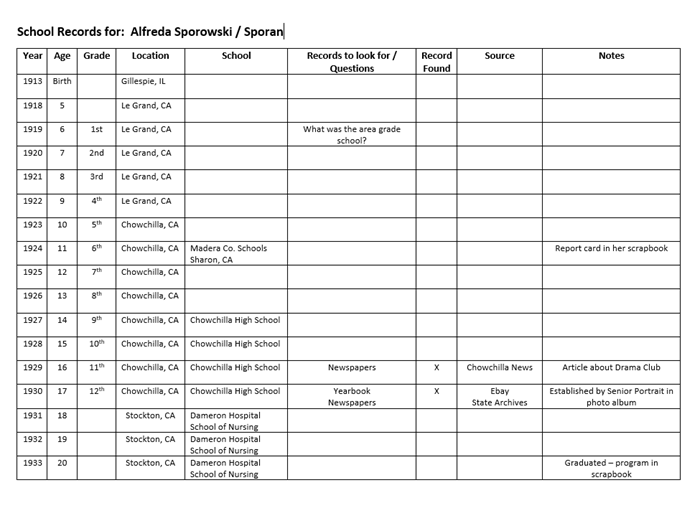
Here’s an example of a worksheet I started on searching for my Grandma’s school records.
Free Bonus Download: Click to download the blank school records worksheet for your own school research use.
2. Consult Family Papers and Books for School Records
Go through old family papers and books looking for things like:
- school photos
- senior calling cards,
- high school autograph books,
- journals and diaries,
- fraternity or sorority memorabilia,
- yearbooks and more.
When I dug through boxes and my grandmother’s cedar chest I found several records like…
a Report Card:
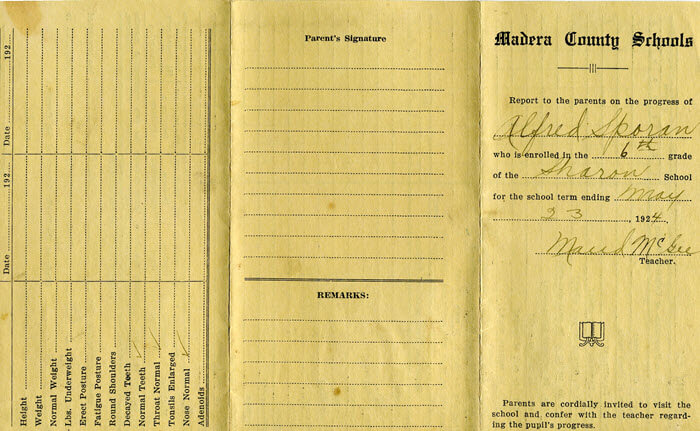
My grandmother’s brother’s 6th grade report card found among family papers.
Grandma’s class picture from the 7th grade in 1925, Chowchilla, California. She is in the back row on the far right, and her brother is the boy in the center of the back row:
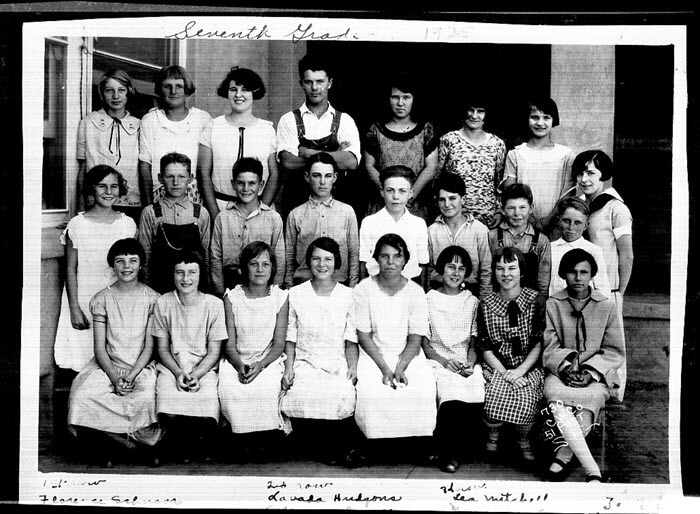
Grandma (back row, far right) with her 7th grade class.
And Grandma’s senior portrait, 1930:
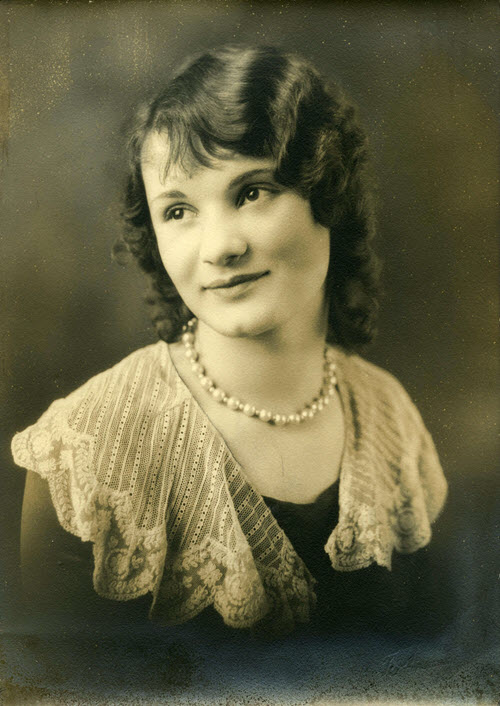
Grandma’s senior portrait from 1930
3. Google for Academic Family History
From the professional website of the state archives to the family history site cobbled together by a cousin you’ve never met, the potential for finding school records on the vast expanse of the internet is limitless! Google is the tool to help you locate websites that include school-related records with lightning speed.
Since I’m not sure which school my grandmother attended, I started off my search for my grandmother’s school with a simple query for the history of schools in the county where she lived as a child:
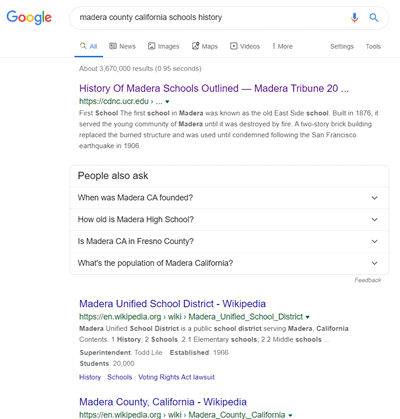
Google search for the history of school’s in the county
I was pleasantly surprised at the first search result. It’s a newspaper article from the Madera Tribune literally outlining the history of how the schools evolved in the county! It details such things as the driving forces behind where schools were located, when they were founded, and which ones at the time of the article were no longer in existence.
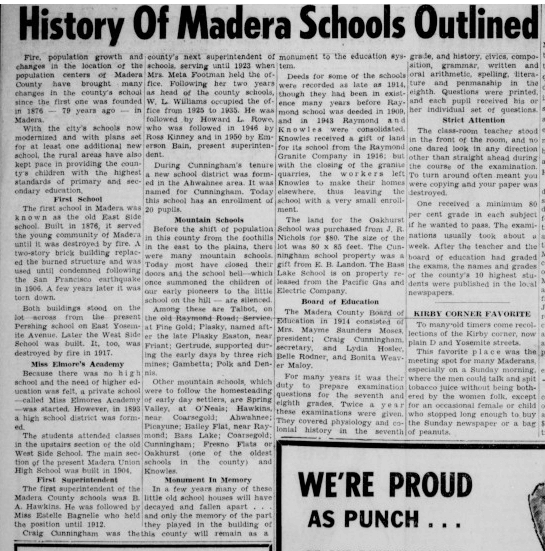
History of Madera Schools Outlined in the Madera Tribune, September 1955.
Next, I focused my attention on the grade school listed on Grandma’s brother’s 6th grade report card that I discovered during my search of family papers. I Googled the name of the school, county and state.
A search like this can literally deliver millions of results. In fact, this specific search brings up over 1 million search results.
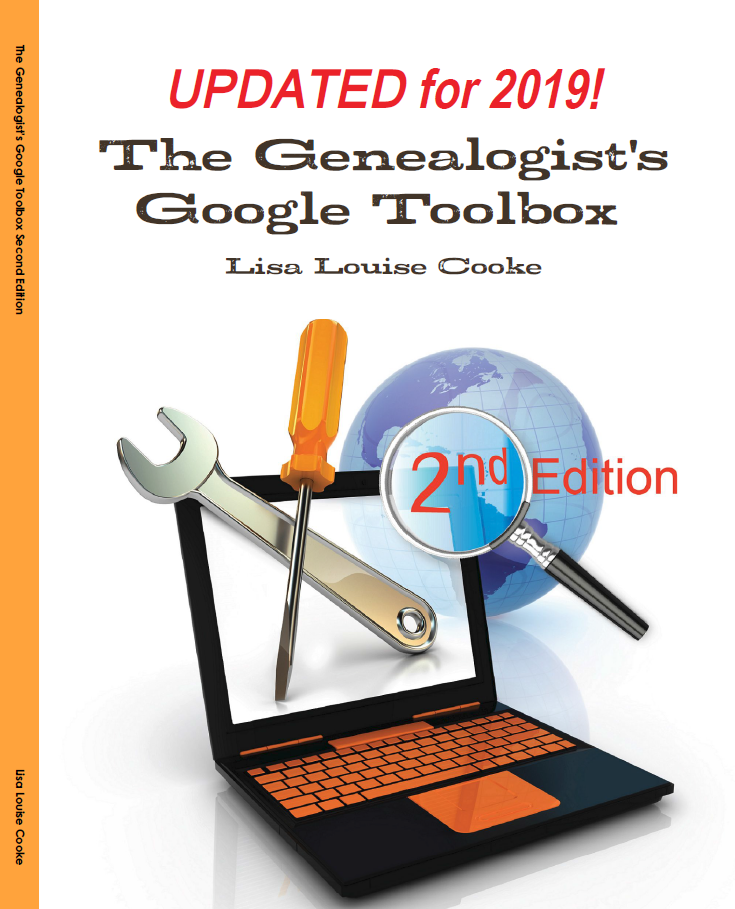 You can typically reduce the unwanted search results by 90% by using search operators. These symbols and words give Google further instructions on what you want done with the words you are searching.
You can typically reduce the unwanted search results by 90% by using search operators. These symbols and words give Google further instructions on what you want done with the words you are searching.
While I cover a large number of operators in my book The Genealogists’s Google Toolbox, I’m going to use just one of the most popular to dramatically improve my search for the Sharon school.
In the example below I put quotation marks around the name of the school. Doing this explains to Google that I want this phrase to appear exactly as I typed it in every single search result. You’ve probably noticed that when you search a phrase by itself, you’ll receive results that include only one of the words, or the words spelled differently, or in a different order. The quotation marks search operator prevents this from happening. It mandates that the phrase appear on every result exactly as you typed it.
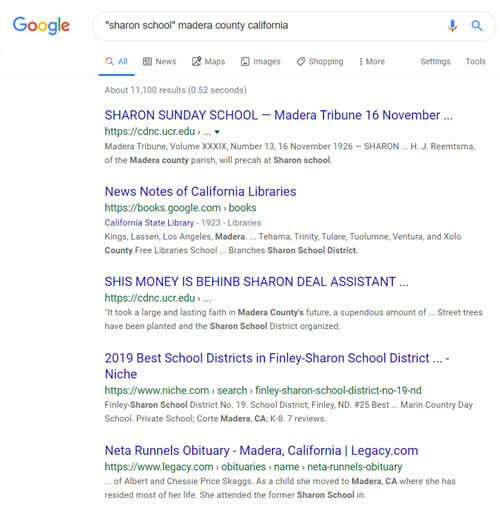
Using Search Operators to Google the Grade School
Notice that I didn’t put quotation marks around the county name or the state. I recommend using search operators sparingly, at least in your initial search, to ensure that you don’t miss out on good results. If I were to put quotations marks around “Madera county” I would not receive any web pages that do mention Sharon School but just don’t happen to mention Madera County as a phrase.
Notice also that this search resulted in just over 11,000 results, a small fraction of what I would have received had I not used the quotation marks! Even more important is that the results on the first few pages of are all very good matches.
I could try a few more variations such as adding words like history, genealogy or records.
4. Search Newspapers
Historic newspaper are also a wonderful source of honor rolls, school sporting events and anything else having to do with school life.
While there are certainly more historic newspapers online than ever before, it’s still a fraction of what is available.
A visit to the Chronicling America website can help. At the home page click the U.S. Newspaper Directory button:
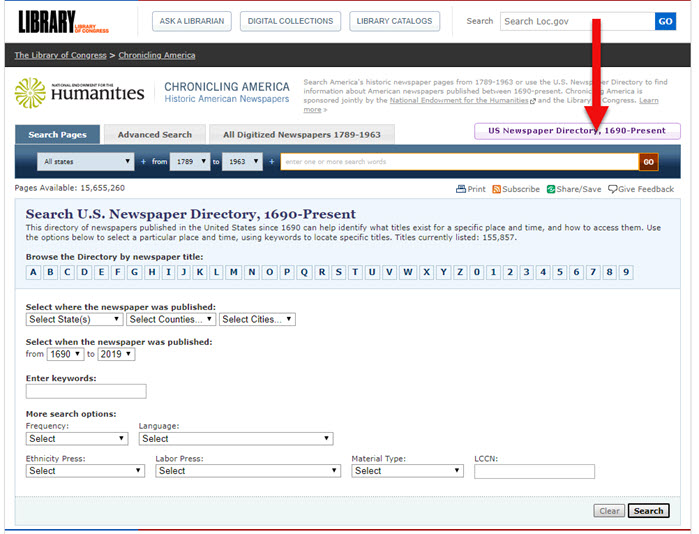
Click the U.S. Newspaper Directory button at Chronicling America
On the Directory search page, enter the state, county and town:
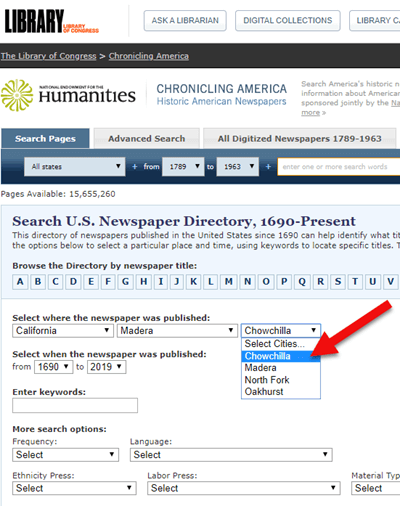
Search the U.S. Newspaper Director for the school location.
On the results page, click the “View complete holding information” link:
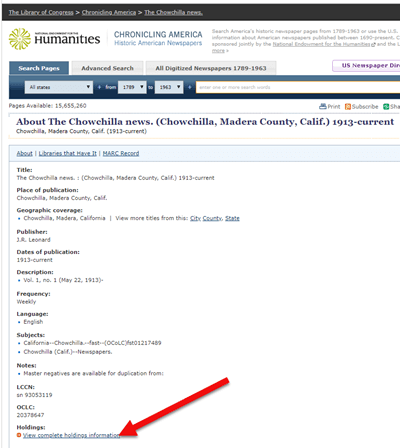
Click “View the holdings”
Now you can view all of the known available locations for this item:
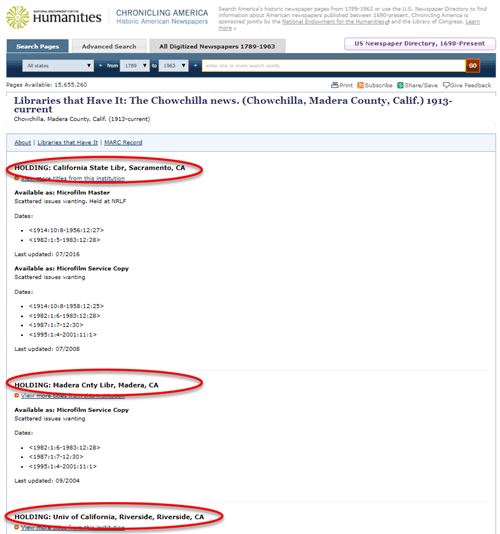
The item I searched for has three known locations.
In my case, the Chowchilla newspaper of the early 20th century has not been digitized and is not available online. However, the California State Archives in Sacramento has an extensive collection of microfilm. I was able to make the trip in person, and was certainly glad I did! They not only had the newspaper I needed but also countless other resources that were helpful for my genealogical research.
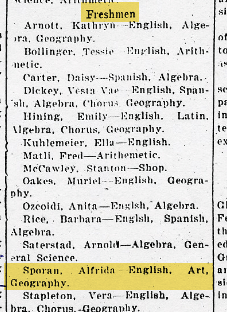
My Grandma listed by name in the newspaper for making the Freshman high school honor roll.
Here are additional resources to help you find newspapers for your school records research: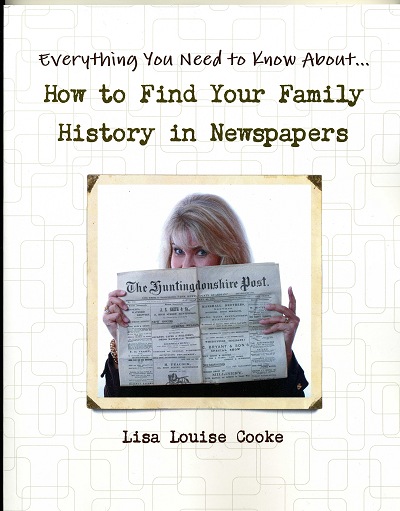
- Local newspapers can also be found by searching for the public library website in the town where your ancestor attended school. Check the library’s online card catalog or contact them directly to see what newspapers they have and whether any can be loaned (on microfilm) through inter-library loan.
- Click here to visit Newspapers.com by Ancestry website. This is a subscription website with over 14,900+ newspapers from the 1700s–2000s and millions of additional pages being added monthly.
- Click here to search Genealogy Bank – (This page includes a 7 day free trial option.) This popular subscription website has over 11,000 newspaper, 95% of which Genealogy Bank says are exclusive to their website.
- My book, How to Find Your Family History in Newspapers provides a newspaper search methodology including all of these suggestions plus many more. Click here for a special discount savings at the Genealogy Gems store. (Disclosure: The links above are affiliate links. Genealogy Gems will be compensated if you click them and make a purchase. Thank your for supporting this free article and the free podcast.)
5. Consult U.S. State Archives and Libraries
The public libraries and state archives across the country are a treasure trove of genealogical resources, and that includes school-related records.
While it’s easy to stop by your local library for a search, it may not be as easy to make your way to the public library in the town where your ancestors lived. Turn to the internet to do your homework regarding the repositories, their holdings, and the most convenient and economical way for you to access them.
A great place to start is the WorldCat website.
Start by conducting a search. Once you find an item of interest, enter your zip code under the “Find a Copy in the Library” section to identify where it’s available.
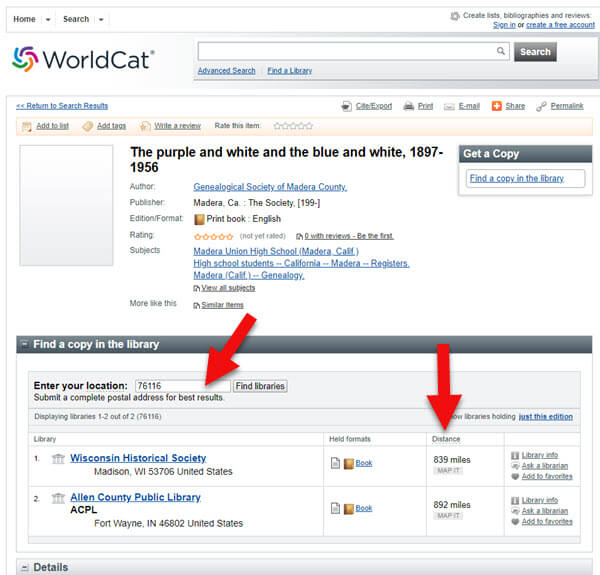
Enter your zip code to determine your proximity to the libraries and archives.
As you can see, the name of the libraries are hyperlinked so that you can click through to the item on their website. This makes requesting a look-up or photo copy very easy.
I can’t stress the value of State Libraries enough. Gere are two more excellent resources:
- Click here for the List of U.S. state libraries and archives at Wikipedia.
- Click here to read Archivist Melissa Barker’s article called Using Veritcal Files in Archives.
6. Contact State Historical and Genealogical Societies
In addition to newspapers, state historical and genealogical societies might have old yearbooks, school photograph collections or other records. For example, the Ohio Genealogical Society library has a large collection of Ohio school yearbooks.
Local historical and genealogical societies may also have school memorabilia in their small or archived collections.
To find contact information for a local historical or genealogical society, Google the name of the county and state and add the words genealogy, history and / or society at the end. For example: Darke County Ohio genealogy society.
7. Search for Online Yearbooks
One of the most exciting genealogical record collections to have come out in recent times is Ancestry.com’s U.S. School Yearbooks 1900-1999 collection. It is an indexed collection of middle school, junior high, high school, and college yearbooks from across the United States.
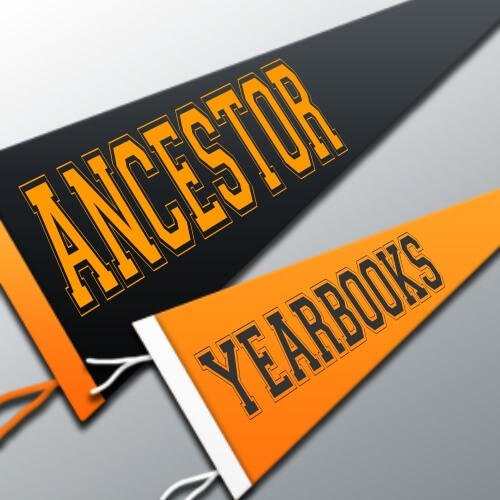
In June of 2019 Ancestry replaced old records with new updated records for most of the yearbooks found on the site. They also added new records from 150,000 yearbooks that previously only had images available. Later in August of 2019 they improved the collection even further by adding a staggering 3.8 million new records. This update also included 30,000 new image-only books.
Ancestry also has an extensive indexed collection of middle school, junior high, high school, and college yearbooks for Canada. Click here to search the Canadian collection.
Additional websites featuring yearbooks include:
Old-Yearbooks.com – According to the website, “Old-Yearbooks.com is a free genealogy site, displaying old yearbooks, class rosters, alumni lists, school photos and related school items. All materials on this site are the property of the submitter. You may not use the images, text or materials elsewhere, whether in print or electronically, without written permission from the submitter or this site.”
Classmates.com – “Register for free to browse hundreds of thousands of yearbooks! You’ll find classic photos of friends, family, and even your favorite celebrities. Viewing the books is always free, and you can purchase a high-quality reprint.”
8. Check Township Archives
You might be thinking you didn’t read that right, but you did. Townships are small areas within the county. These small townships may have their own archives or one room museums. They are often the holders of some pretty one-of-a-kind finds.
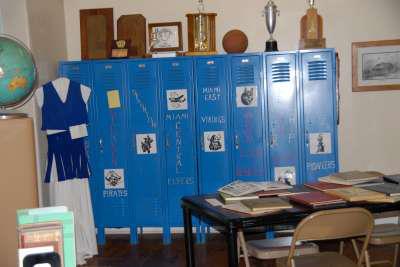
The best way to determine what the township may have is to contact the township trustees. Google your township name, the county name, state name, and add the word trustee. You will likely need to give one of the trustees’ a phone call to ask what resources might be available.
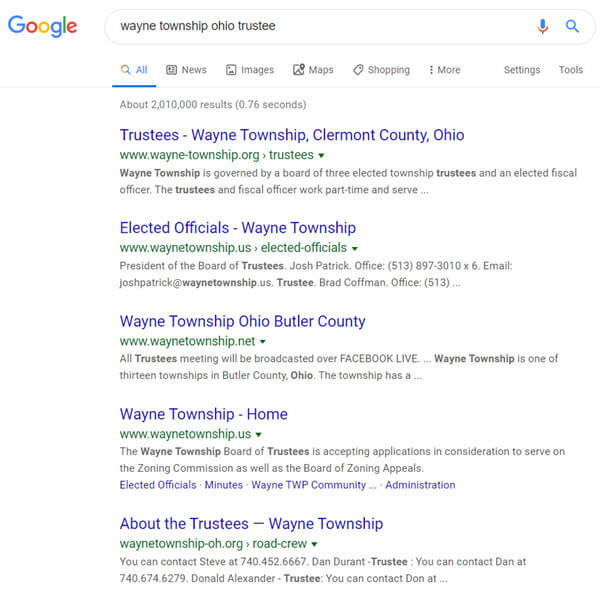
Google search examle
The auction website ebay is the perfect place to look for school record and memorabilia, particularly hard-to-find yearbooks.
Conduct a search on the school or town you are looking for to see if anyone is selling a yearbook that you want. (You’ll need a free ebay account to do this.) Also, search for old photographs or postcards of the school building that you can add to your family history.
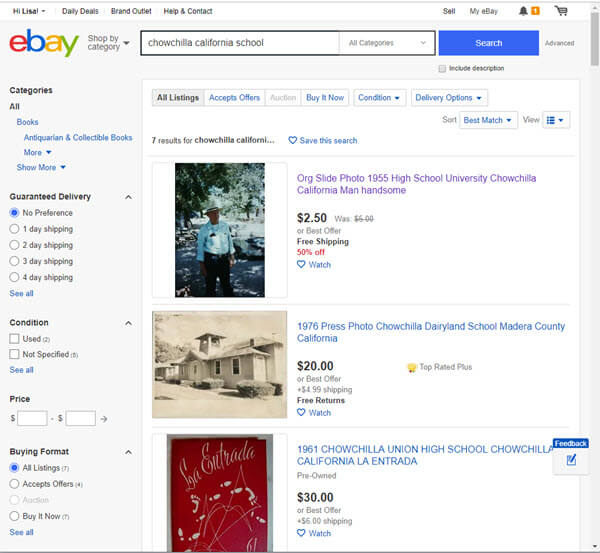
Initial search for school items at ebay
When I searched for Chowchilla California School, several auctions for school-related items from Grandma’s high school came up. Unfortunately, these are auctions for yearbooks after she had already graduated. But no worries! This search is only for today. Tomorrow someone could put up an auction for exactly what I want. There’s only one problem: no one has enough time to search every single day!
A way to save time and ensure that you don’t miss new auction items is to save your search.
Click the Save this search button toward the top of the page:
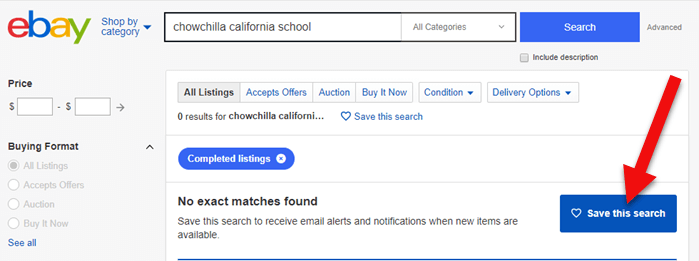
Click the Save button to save the search you just ran.
By doing this, you will be sent an email any time a new auction comes up that meets your search criteria. You can learn more about setting up ebay saved searches for family history by listening to Genealogy Gems Podcast episode #140.
Here’s another one of my favorite strategies: After you run your initial search, check the box on the results page to include completed listings.
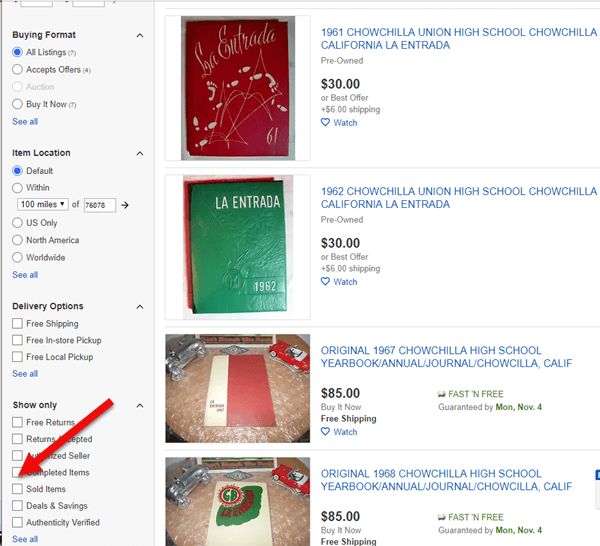
Click the Completed search box in the left hand column
In the revised “Completed” search results you may see some items that are of interest. If the item has a green price, it means the item was sold. If the price is black, it did not sell.
Each item will also have a link that says View Similar Active Items. Click that to see a list of items currently for sale that are very similar to one that you wanted.
You can also contact the seller of any item to inquire about the unsold item or to ask whether they have related items.
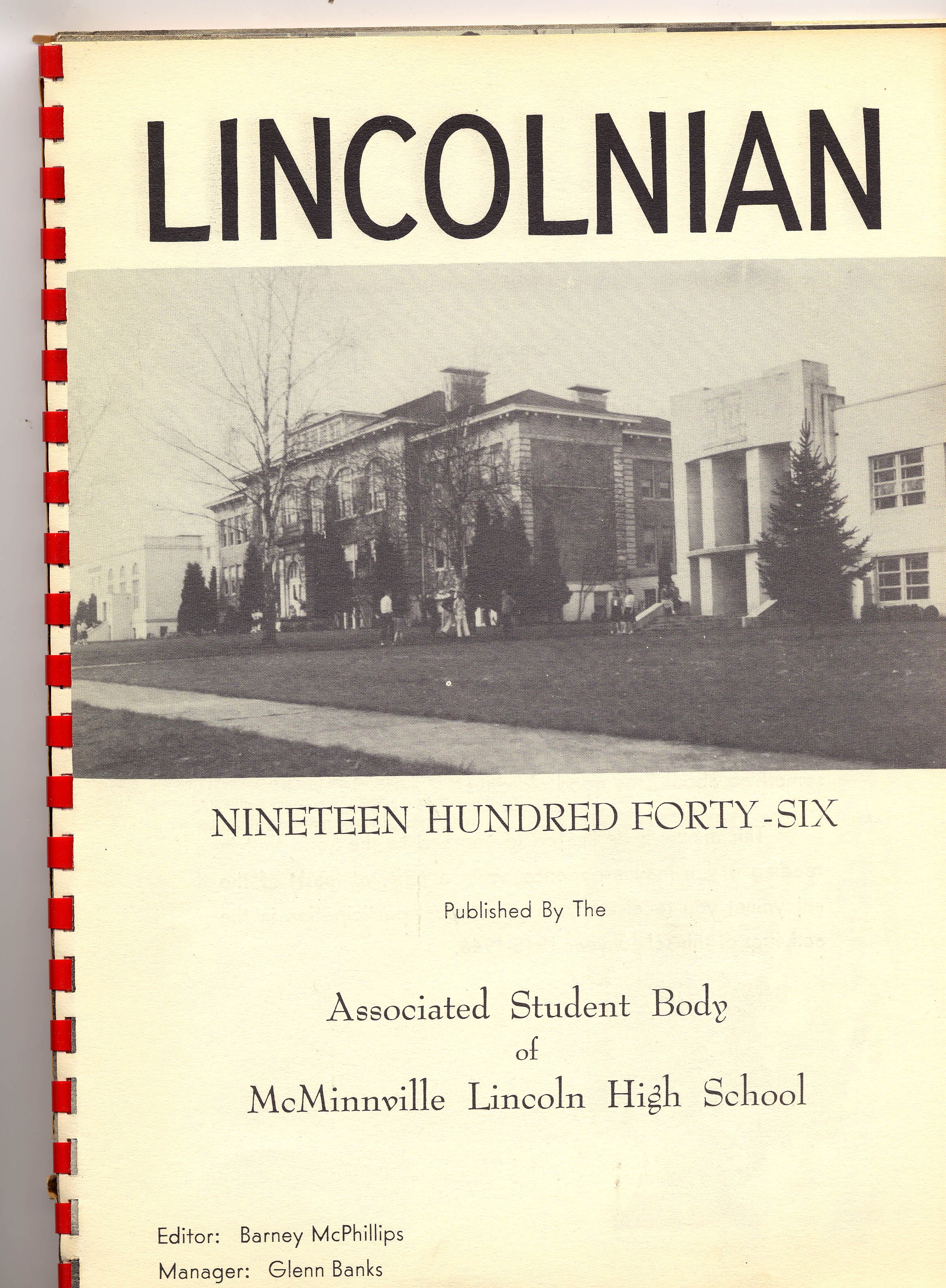
Bought on ebay: A yearbook from the school where my husband’s grandfather was a music teacher
I bought the yearbook above on ebay several years ago. It includes several photographs of my husband’s grandfather who was a music teacher at the high school back in the 1940s.
10. Call the School
If the school is still in operation, try calling the main office of the administration office. They may have old yearbooks and scrapbooks in their library or on display. If they don’t, they may very well be able to tell you where they can be found.
You can obtain contact information by Googling the name of the school and the location.
Good times to try calling a school are mid-morning after kids are settled into class, or between 3 and 4:00 pm local time, when many of the kids have gone home but the school office is still open.
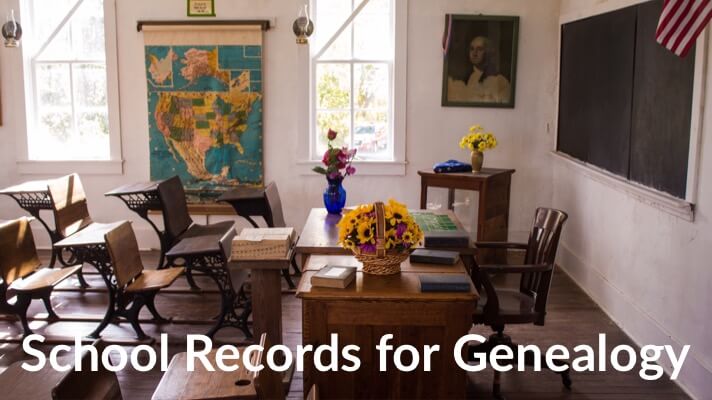
Tell Us About the School Records You Find
Using these strategies you are bound to find more school records for your genealogical search. Please leave a comment below and share what you found, where you found it, and which strategy you used. It will inspire us all to keep looking! And if you have a favorite strategy that we didn’t mention here, please do share that too.
Learn More by Listening to the Free Podcast
Have you listened to the Genealogy Gems Podcast yet? The free podcast has been downloaded nearly 3 million times worldwide. Why not tune in and see what everyone’s been listening to? You’ll get tech tips, inspiring stories, research coaching and please-try-this-at-home examples you’ll want to try right away!
by Lisa Cooke | Oct 21, 2019 | 01 What's New, DNA |
Here’s the latest DNA update quoted from Ancestry®:
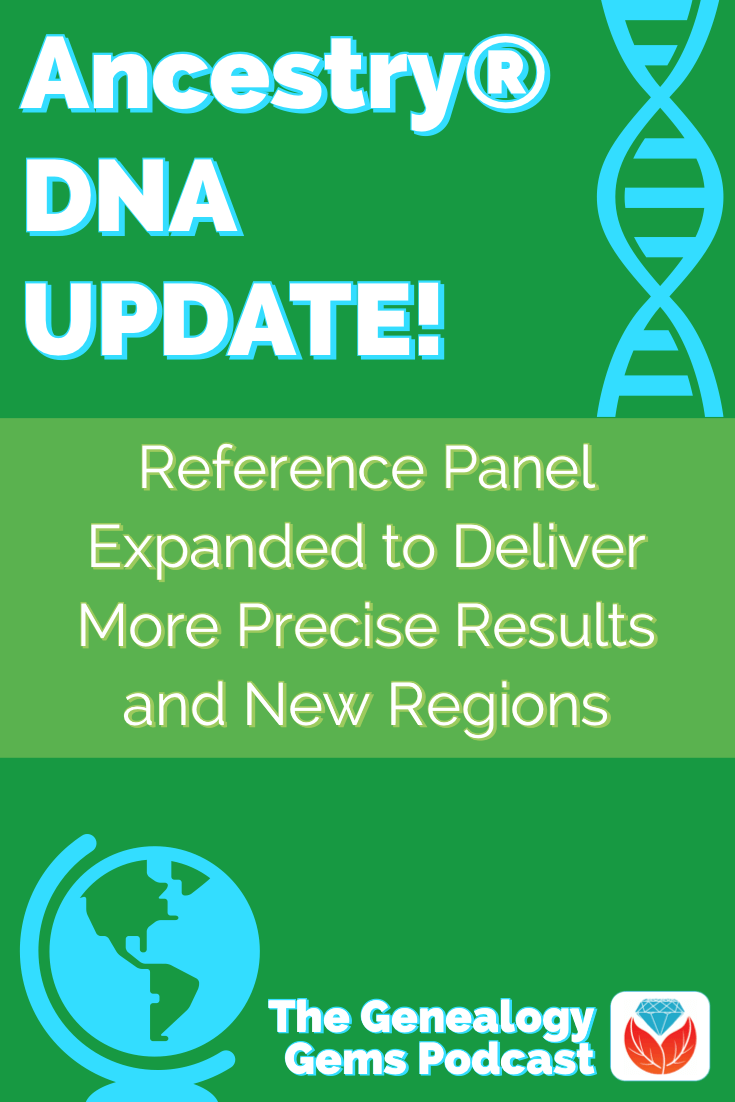
Ancestry® Expands Reference Panel to Deliver More Precise Results and New Regions
“Today, Ancestry® announced their latest update to AncestryDNA® ethnicity estimates.
This update was made possible thanks to an increase in the AncestryDNA reference panel.
The reference panel is now more than double its previous size with samples from more places around the world, allowing Ancestry to determine ethnic breakdowns with a higher degree of precision.
New ethnicity estimates will roll out to new and existing customers over several months, resulting in these potential developments for customers.”
New Ethnicity Regions
From their blog post:
“For example, previously we had North and South America as two large regions: Native American–Andean and Native American–North, Central, South.
With this new update, we are able to refine the areas into 11 smaller ones.
If you received one of the older regions before, your new report will most likely have one of the newer, more precise regions instead like Indigenous Eastern South America, Indigenous Cuba, and Indigenous Americas–Mexico, among others.”
More Global Regions
“This advancement will enable AncestryDNA to deliver even more regions globally to enhance the experience across diverse populations including improvements and region realignment in West Africa, northwestern Europe, the Americas, Oceania, and South Asia.”
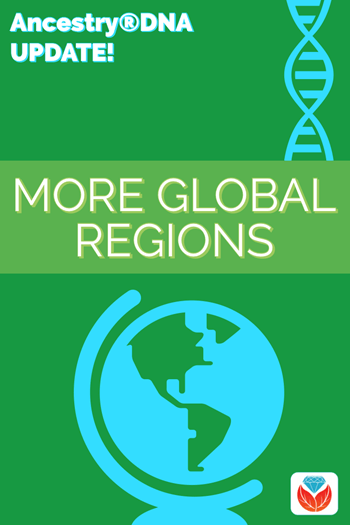
When You Will See the Update
“It’s important to note that we are phasing the update over time to ensure individual attention is given to delivering each result; therefore, some may see results earlier or later than others.”
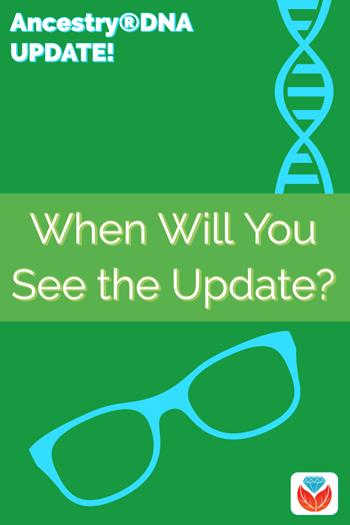
Read the Full Announcement
Get all the details on this new update announcement by reading their article Ancestry® Expands Reference Panel to Deliver More Precise Results and New Regions.
List of AncestryDNA® Regions
“More than 1,000 global regions make up the ethnicities displayed in our DNA test. As DNA science improves, the number of regions we test for (and the countries covered in each region) may change.
This article lists each region, but to see which areas of the globe are included in the regions, you’ll need to view the list from your DNA Story page (which will highlight an area of the map when you click a region).
To see all the regions, click See other regions tested at the bottom of your ethnicity estimate and click on a region on the next page.
Ethnicity Estimate FAQ
Check out the interactive map and watch the explanatory video: FAQ for new AncestryDNA ethnicity estimate.
Results May Vary, Here’s an Example
If you’ve taken a DNA test, you may have received different ethnicity results than you expected and different from your family members. DNA expert Diahan Southard explains why this happens in the Genealogy Gems article “Results May Vary:” One Family’s DNA Ethnicity Percentages. Click here to start reading now.
Click here to pick from our vast collection of DNA articles including DNA Ethnicity Accuracy: How It’s Getting More Specific.
More Resources
Get the DNA SUPER BUNDLE: 10 Quick Reference genetic genealogy guides by Diahan Southard at the Genealogy Gems store.
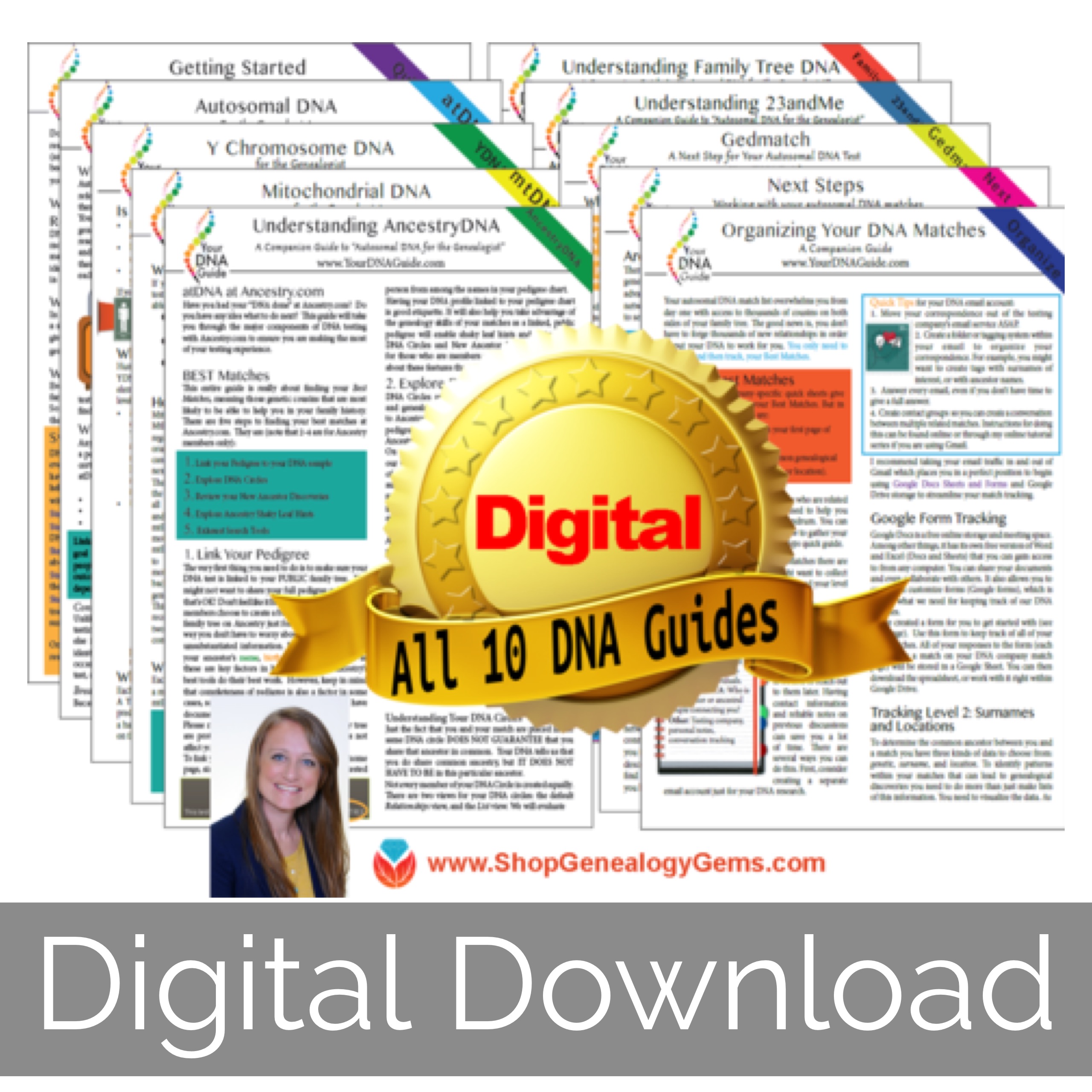
10 DNA Genetic Genealogy quick reference guides by Diahan Southard available now at the Genealogy Gems Store.
What Do You Think?
Have you noticed the update in your AncestryDNA® account? Did this update deliver any surprises? Please leave a comment below and share what you learned.
by Lisa Cooke | Oct 21, 2019 | 01 What's New, Google, Technology |
We probably spend more time staring at our web browser than we do staring into the eyes of our loved ones. Since that’s the case, wouldn’t it be nice to be looking at a browser tab that not only makes you more productive but also inspires you? Well, you can and today I’ll show you how in the Chrome browser.
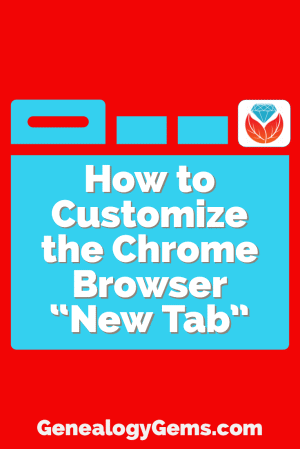
Plain Jane Chrome Browser Tabs
Normally when I click the plus sign on the right end of my browser tabs it opens a new tab that isn’t much to look at:
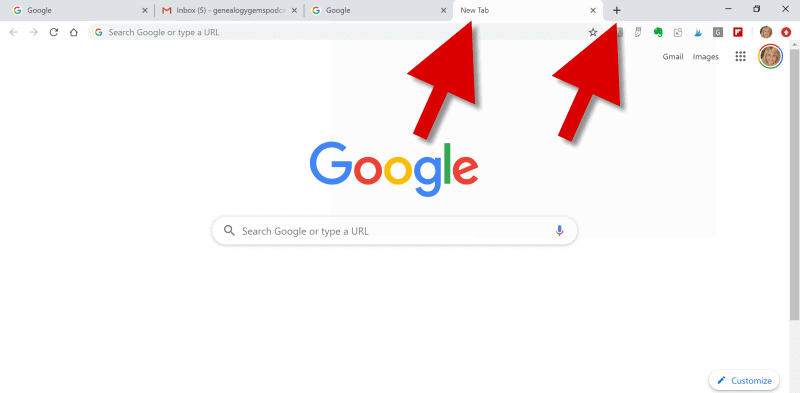
(Image above: Clicking the Plus sign opens a new browser tab.)
Well, recently I have been customizing the “New Tab” on my Chrome web browser, and the results have been helpful and enjoyable.
Now I find myself smiling each time I open a new browser tab. There, looking back at me, are ancestors. They are happily picnicking in a meadow under shady trees. They look relaxed in their white cotton shirts, sleeves casually rolled up, and glass bottled soda in hand.
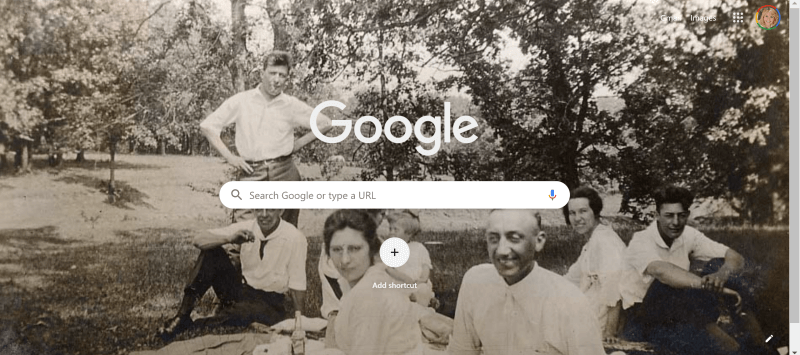
(Image above: Chrome new browser tab with custom image.)
This sepia tone photo was taken early in the 20th century. It not only inspires me to keep up the genealogical search I am on, but also to take a chill pill when I hit a stubborn research brick wall.
Keep reading and I’ll show you how to add your own custom image to Chrome’s New tab.
Benefits of Customizing Chrome’s New Tab
My New Tab features more than just an old family photo. It also increases the speed of my online navigation by serving up the websites I need and use most often.
Notice the website shortcut icons I’ve added to the bottom of the page (image below.) With one click I’m on my way to search for historic newspapers at the Library of Congress Chronicling America website, or peruse the latest records at MyHeritage.
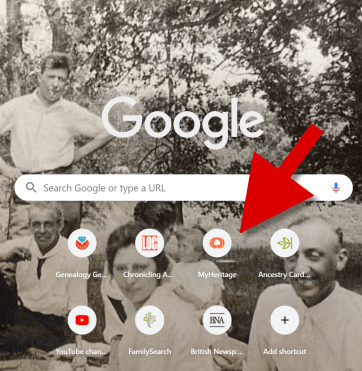
(Image above: Website shortcuts)
Customizing the New tab on your Chrome web browser can also increase your search speed.
Notice the suggested related searches that fall between the search query box and the customized website shortcuts. Google has the ability to suggest additional searches based on my most recent previous search.
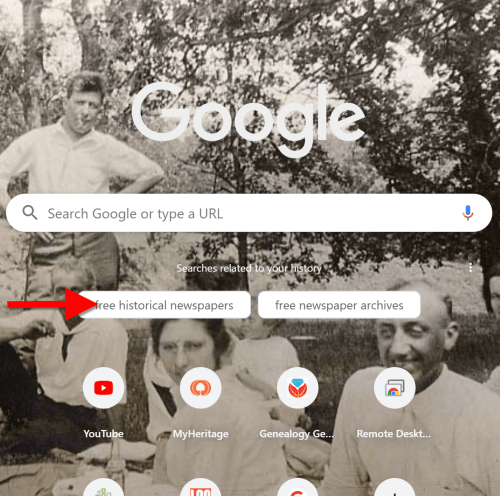
(Image above: Related searches suggested in Chrome’s New Tab.)
So why would this be beneficial?
Envision yourself conducting a Google search for a particular record collection. You receive the search results, and several look promising. You may even click through to one of those results and start reviewing the page. But as you read, it occurs to you that there may be a better way to state your query that could deliver better results. Or perhaps you wonder if you’re using the best terminology.
Rather than losing the search you’ve already run (and that website you’ve already started reading), you open a New web browser tab. With a customized New Tab, Google will start you out with some suggestions for additional searches. These aren’t just random. Google takes into account the most popular type of searches on the topic and the terminology or keywords that it has determined would retrieve good results.
Is it perfect? No. But suggested related searches can give you a jump start, and lead you to results you might not have otherwise found.
Google’s Customization versus a Browser Extension
Now before I show you how to customize your New Tab, you may be wondering why I’m not just using a browser extension to do the customization.
Yes, there are a variety of Chrome browser extensions that allow you to change the New Tab page. But the answer to this question comes down to security. Browser extensions have the potential to leak your private information. It’s always best to stick with the Google customizations if possible.
Since we don’t spend that much time on the New Tab page, the features we are about to customize should be all we need. However, if you decide to use a browser extension, I encourage you to do your homework to do your best to determine if the extension is trustworthy.
How to Add Your Own Image to the Chrome Browser New Tab
Probably the most difficult part about customizing the background of the New Tab is selecting the photo!
I spent more time on picking my photo than I did actually setting it up. But don’t fret too long about it. It’s so easy to change the image that you can change it on a daily basis and rotate images if you just can’t make up your mind. Let’s get started:
1. Click the Plus sign
At the top of your browser, click the plus (+) sign on the far right to open a New TabYou can also open a New Tab by using the keyboard shortcut Ctrl + T.
And here’s a tip: Keep the tab that this article appears in open so that you can easily jump back and forth between the instructions and the customization page.
2. Click the Customize button
You’ll find the Customize button in the bottom right corner of the page.
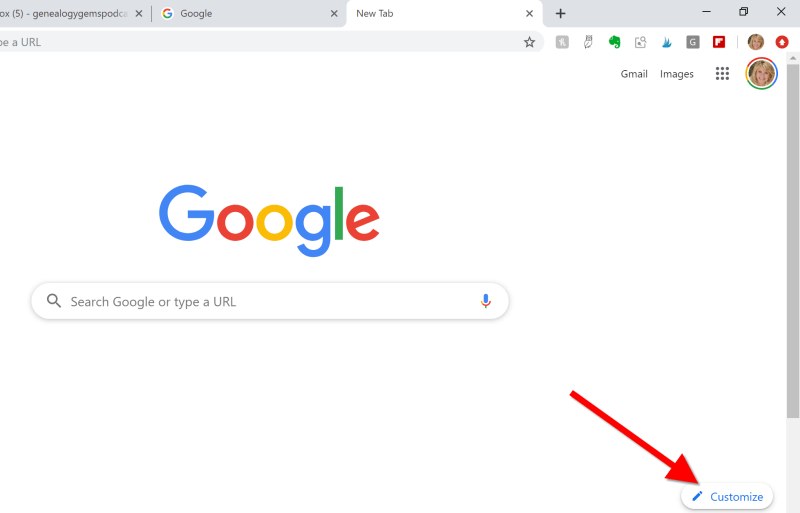
(Image above: On the New Tab, click the Customize button.)
3.Upload the image
Select Background and click Upload from device:
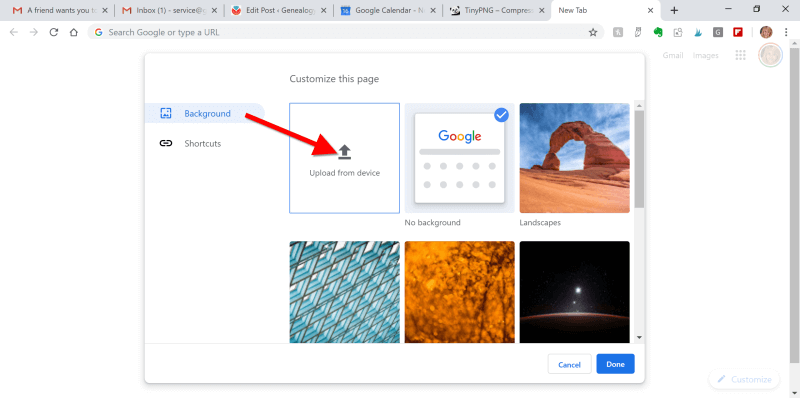
(Image above: Upload image to the Chrome browser)
4. Find the Image
An Open dialog box will pop-up. Navigate to the desired image on your hard drive.
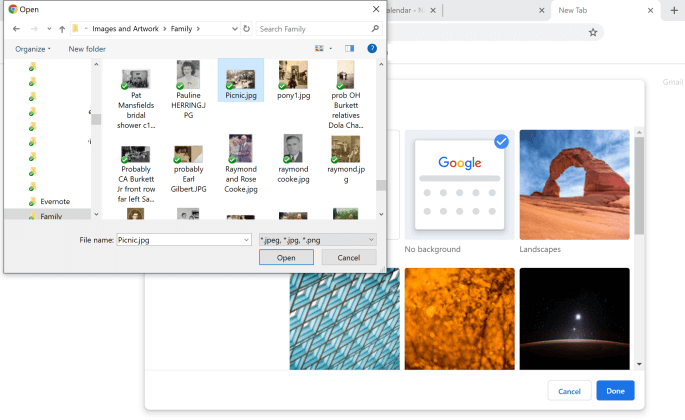
(Image above: Navigate in the “Open” dialogue box to the image that you want to use as your custom New Tab background.)
5. Select and open the image
Click to select the image and click the Open button. The image will now fill the screen. Don’t worry, you haven’t uploaded your photo into the public Google search engine. You are only customizing your Google account, and only you can see the photo.
Landscape images work the best for the New Tab page background. If you have a Portrait shaped photo, try cropping it to more of a landscape shape before uploading.

(Image above: Chrome new browser tab with uploaded image.)
If you want to change it back to plain or swap photos, simply click the customize icon in the bottom right corner that looks like a pencil.
How to Add Shortcuts to the New Tab
Now that you have your family looking back at your from your New browser tab, let’s add shortcuts to your favorite websites.
1. Click the Plus sign
Click the “Add Shortcut” plus sign beneath the search field.
2. Add the name and URL
Open a new tab, navigate to the desired web site, and then copy the URL in the address bar. Go back to the tab with the customization page, and in the Edit Shortcut window, type the name of the website, and paste the URL you just copied.
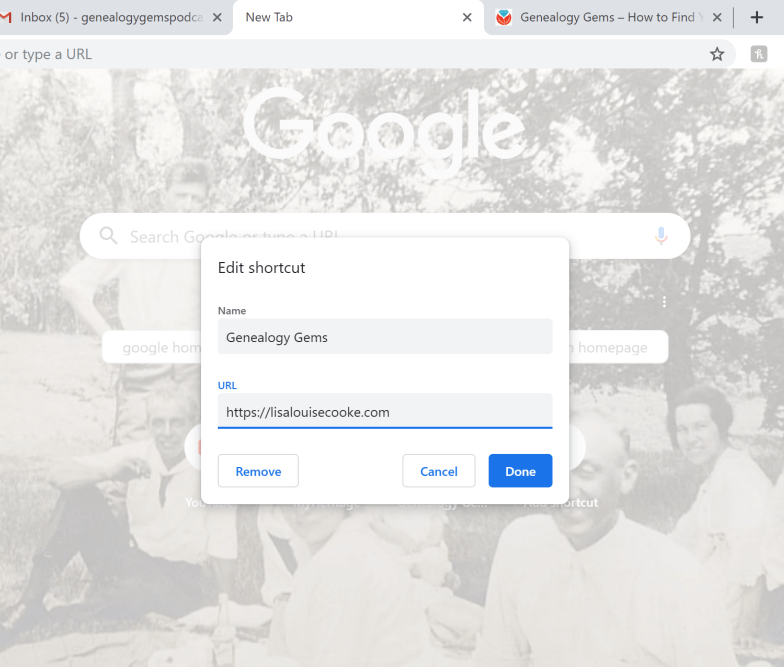
(Image above: type in the website name and URL.)
3. Click the Done button
Once you click the Done button, you will see your new shortcut below the search field.
4. Repeat
Repeat the process to add additional website shortcuts.
5. Edit Shortcuts
If you want to change one of the shortcuts that you’ve added, hover your mouse over it and click the three vertical dots in the upper right corner of the icon.
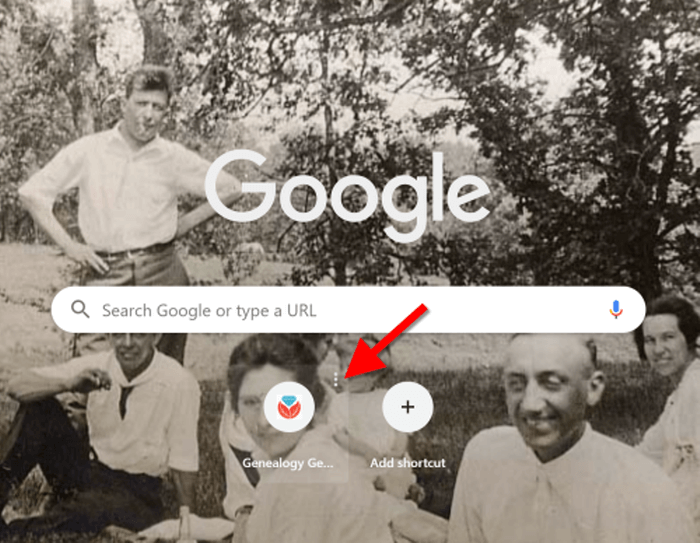
(Image above: Hover your mouse over the shortcut and click the three vertical dots to edit.)
Then you will have the option to edit or remove the shortcut.
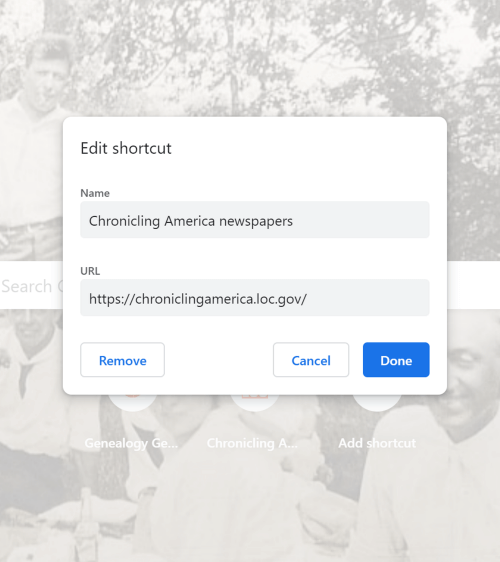
(Image above: Edit shortcut dialogue box.)
Related Search Prompts on Chrome’s New Tab
As I mentioned earlier in this article, Google will provide related search suggestions when you open a new tab. You fill find them between the search query box and the shortcuts.
These can be helpful in providing you additional keywords worth searching. Google bases these prompts on what people usually search for. Here’s an example of the related searches that appeared when I searched for Historic Newspapers:

(Image above: Related searches suggested in Chrome’s New Tab.)
These search suggestions will change as you search for different things using Google.
How to Remove Related Search Prompts
Not everyone appreciates Google’s efforts to be helpful. If you would rather see more of your background photo and not the related search prompts, they are easy to remove.
Simply click on the three vertical dots just to the upper right of the prompts:
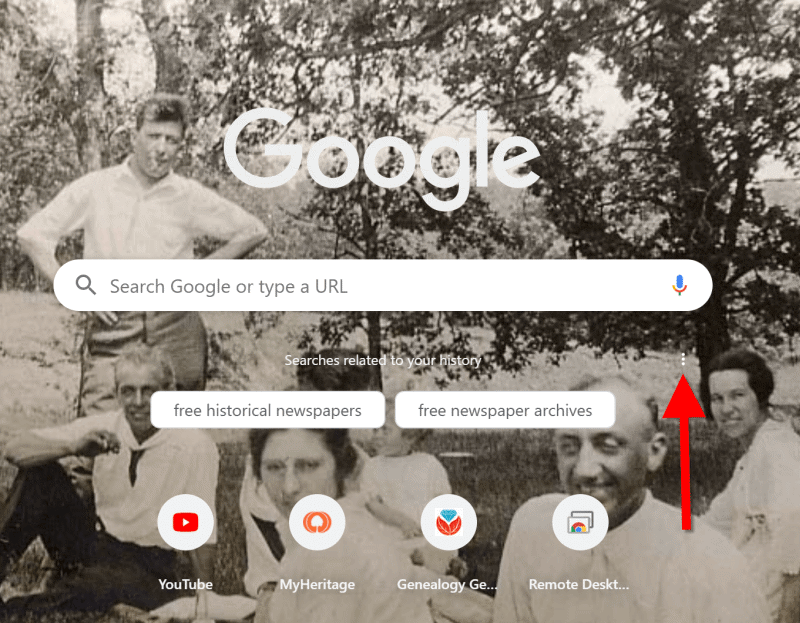
(Image above: Click the three vertical dots.)
In the pop-up balloon you have two options:
- Don’t Show This Topic tells Google not to show the topic appearing on the tab again. In my example, I would not use this because I expect to be searching for historic newspapers again in the future. But if my search were just a one time thing, or the search prompts were completely irrelevant, then I would let Google know I don’t want to see this topic in the future by selecting this option.
- Never Show Suggestions tells Google to never show suggestions on the New Tab again.
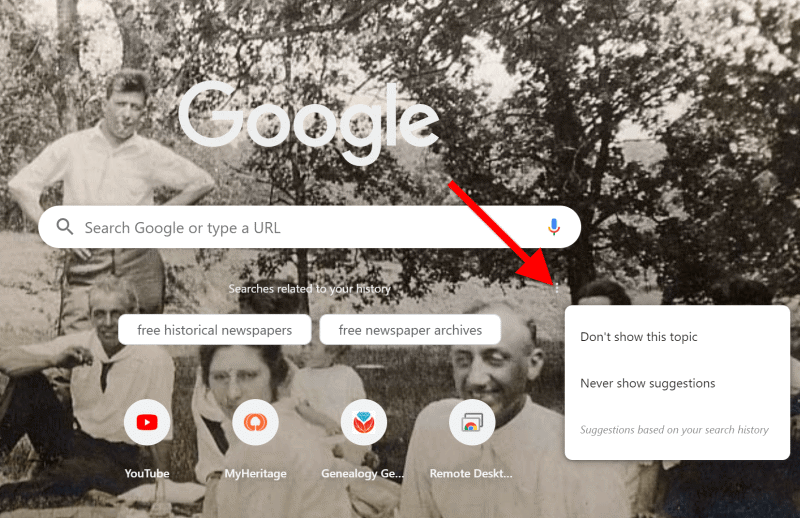
Make your changes in the pop-up balloon.
How to Return to the New Tab Default Settings
I love having a customized New Tab to greet me each time I click the plus button. However, there may be a time when, for whatever reason, you will want to return the New Tab to its original state. That’s easy enough to do! Here’s how to remove or change the background image:
Click the pencil icon in the bottom right corner of the screen. This will take you back into Customize mode.
If you don’t want any background image, click No Background. If you would like something completely different, you can also select from a collection of photos provided by Google:
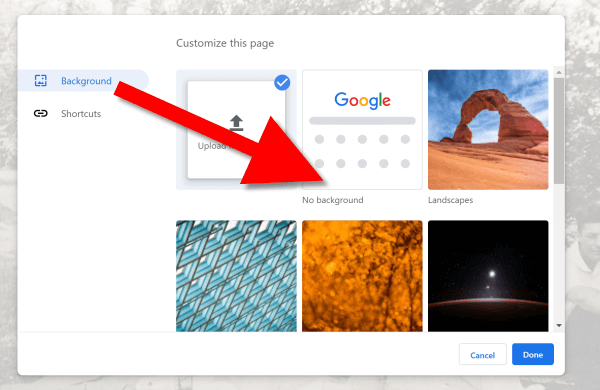
To remove the background image, select Background > No Background
In this same pop-up dialogue box you can also remove your shortcuts in one swoop. Click Shortcuts and then Hide Shortcuts, and then click Done:
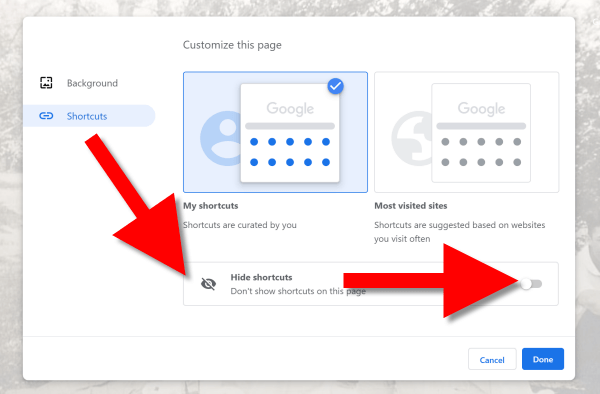
More Googly Ideas

I hope you’ve enjoyed this simple way to spice up Chrome’s New browser tab. You’ll find tons of exciting ideas on how to use Google more effectively for genealogy and family history in my book The Genealogist’s Google Toolbox.
If you’re a Genealogy Gems Premium eLearning member, check out my current full-length Google search video classes. (Image below.) P.S. Don’t forget to download the PDF handout for each class!
If you’re not a member, but would like to be, click here to learn more.
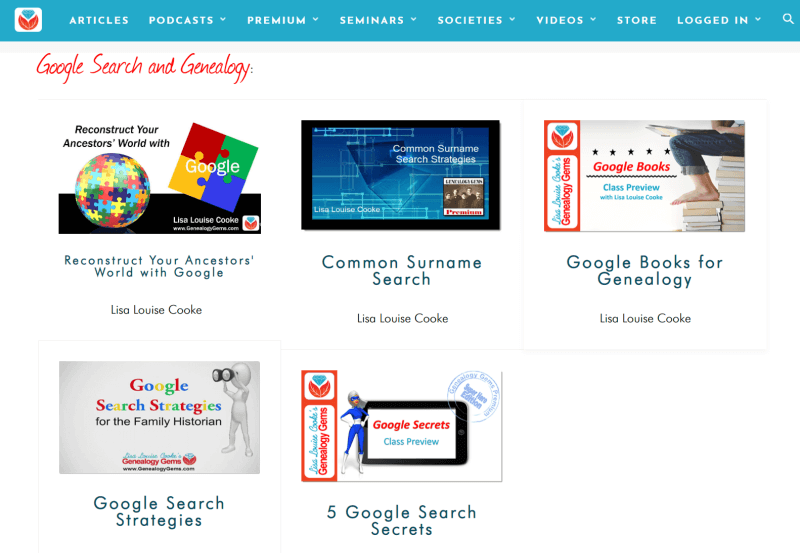
Full length Google search classes available to Genealogy Gems Premium eLearning Members
Happy Googling!
by Lisa Cooke | Oct 14, 2019 | 01 What's New, MyHeritage
The second annual MyHeritage user conference, MyHeritage LIVE 2019, was held in Amsterdam.

Below you’ll find a list of lectures from the conference which are now online. These sessions, given by world-renowned experts and valued MyHeritage staff, are now available on MyHeritage Education.
If you missed the conference or the live stream, you can now take watch these video recordings for free, from the comfort of your own home, at any time, and at your own pace.
Pick from this List of MyHeritage Video Classes
Here is a list with a full description of each and links to watch them:
Opening Session: Keynote by MyHeritage Founder and CEO Gilad Japhet
In his keynote address at MyHeritage LIVE, MyHeritage Founder and CEO, Gilad Japhet, talks about recent MyHeritage achievements as well as upcoming features and projects
Watch
What’s New at MyHeritage
with Maya Lerner
Maya Lerner, VP of Product at MyHeritage, gives a summary of MyHeritage’s new features and a look ahead at future plans.
Watch

Introducing the New Educational Resource Center for MyHeritage Users
with Daniel Horowitz
This presentation will give you an inside look at MyHeritage Education, a new online resource center for enhancing your understanding of the MyHeritage platform.
Watch
Hear my interview with Daniel Horowitz in Genealogy Gems Podcast episode #221.

Searching and Browsing on MyHeritage to Get the Most Out of Your Research
with Cyndi Ingle
With 10 billion historical records, MyHeritage is able to provide the most extensive genealogy searches available on the Internet. Learn how to use them efficiently to find new and relevant information to incorporate into your research.
Watch
Discovering Immigration Stories with MyHeritage
with Lisa Alzo
Every immigrant has a story. Learn how to leverage the immigration records collection at MyHeritage to uncover key clues and make amazing discoveries about your immigrant ancestors from both sides of the pond.
Watch
Lisa Alzo has been a guest blogger here at Genealogy Gems. Her articles include Heritage Receipts – Aunties, Sprinkles and the Santa-in-his-cap cookie cutter and 4 Steps to Getting Started with Scrivener Software for Writing Family History.
Using MyHeritage to Find Ancestors from the Netherlands
with Yvette Hoitink
If you have ancestors from the Netherlands, this talk introduces you to the most important records and shows you what you can find online, even if you don’t know any Dutch. Learn how naming traditions and emigration patterns can help you find your Dutch ancestors.
Watch
PANEL: Researching Dutch Family History Around the World
These experts give tips and advice on how to research your roots in Surinam and the former Dutch East Indies.
Watch
Evaluating Your Smart Matches™ and Record Matches on MyHeritage
with James Tanner
Smart Matches™ and Record Matches on MyHeritage supercharge your research. Learn how to review and evaluate these automatically generated matches and effectively use them to advance your genealogical research goals.
Watch
An Overview of Western European Record Collections on MyHeritage
with Mike Mansfield of MyHeritage
With over three billion records from thousands of collections of European origin and a vibrant user community, MyHeritage is an incredible resource for European research. This session will provide an overview of these collections and highlight how to best find access and utilize these sources.
Watch
Using Geni and How it is Different from Other Genealogy Platforms
with Mike Stangel
Learn more about the benefits of collaboration in a single-family tree, including adding sources to shared profiles, communicating with public discussions, understanding the revision history of profiles, and working with projects. Learn how Geni and MyHeritage work together to help improve the quality of the World Family Tree and connect you to new relatives.
Watch
Top Technology Tips for MyHeritage Users & Introduction to Family Tree Webinars
with Geoff Rasmussen
Watch
Developing Your Own Research Plan on MyHeritage
with James Tanner
MyHeritage provides an extremely valuable platform for conducting systematic and source-based research. A formal research plan can help you organize all the information presented in a coherent, useful way, and keep you moving towards your genealogical goals.
Watch
Using Census, Immigration, Newspaper, and Yearbook Records at MyHeritage to Explore the LIves of Your Ancestors
with Lisa Alzo
In genealogy, cluster and collateral research is a key strategy for solving complex brick wall problems. Learn how to use census, immigration, newspaper, and yearbook records at MyHeritage to explore the lives of your ancestors and their inner circles.
Watch

Science for the Non-Scientist: How Does MyHeritage Produce their DNA Results?
with Diahan Southard
DNA test results are a companion to our other research methods. A better understanding of how it all works will lead to better use of the tools for your family history research.
Watch
Diahan has been a regular contributor here at Genealogy Gems. Read her article Adoption DNA Match Strategy: Combine DNA Test Types.
Click the video player below to watch my conversation with Diahan about common genetic genealogy misconceptions:
What Exactly is a Centimorgan? An Introduction to the Science of DNA Testing
with Ran Snir
Whether you have already taken a DNA test or this is the first time you’re hearing about it, in this session we will start from the very beginning. We’ll go over the basic terms of DNA testing and learn how DNA is passed down through generations, how and why individuals have shared DNA segments and how we’re able to estimate one’s ethnicity origins.
Watch
Ran Snir was featured in Genealogy Gems Podcast episode #227. Click here to hear my interview with him on the Theory of Family Relativity™.
Mapping Your DNA Matches on MyHeritage
with Blaine Bettinger
Learn about useful tools to organize your list of DNA Matches, how to differentiate between them, and how to better utilize each tool.
Watch
Using the Theory of Family Relativity™ to Research Your DNA Matches
with Ran Snir
Learn about the revolutionary technology that saves you dozens of hours of research by synthesizing billions of data points to craft multiple theories about how you and your DNA Matches might be related.
Watch
PANEL: The Future of DNA Testing
Roberta Estes, Blaine Bettinger, Yaniv Erlich
This panel of DNA experts discusses the current state of DNA testing and what the future will bring.
Watch
Formulating a DNA Testing Plan
with Blaine Bettinger
DNA testing can be expensive, but DNA evidence is a component of exhaustive research when it is available. Identify some of the ways you can minimize costs while maximizing results by formulating a DNA testing plan early in your research.
Watch
Why You Should Complement Your DNA Data with Genealogy Research
with Diahan Southard
Building a family tree is free and adds a lot of value to your DNA test. Learn how it can help improve the accuracy of relationship estimates, trace common ancestors to uncover how exactly you are related, increase the chances DNA Matches will contact you, help you identify the family members whose DNA results would contribute the most value to your research, and more.
Watch
The World Wide DNA Web
with Alon Diament Carmel
Alon Diament Carmel, Ph.D., researcher for the MyHeritage science team, explains what we can learn from the vast web billions of DNA Matches about genetic groups and identity.
Watch
Introducing the MyHeritage DNA Health+Ancestry Test
with Yaniv Erlich
Discover how your genes affect your health and explore the valuable insights you can gain from this latest addition to our DNA product line. The MyHeritage DNA Health+Ancestry test gives you dozens of personalized health reports that explain your genetic risk for developing certain conditions, and tell you whether you’re a carrier for hereditary conditions that can potentially be passed on to your children.
Watch
PANEL: DNA Testing for Health
with Yaniv Erlich, Diahan Southard, Roberta Estes
This panel of DNA experts discusses the advantages of taking a Health DNA test to learn more about how your genes may affect your health and empower you for the future.
Watch

 Alabama Deaths, 1908-1974
Alabama Deaths, 1908-1974
































